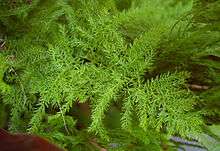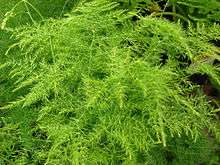Asparagus setaceus
Asparagus setaceus, commonly known as common asparagus fern, asparagus grass, lace fern, climbing asparagus, or ferny asparagus, is a climbing plant in the genus Asparagus.[2] Despite its common name, the plant is not a true fern, but has leaves that resemble one.[3]
| Common asparagus fern[1] | |
|---|---|
 | |
| Scientific classification | |
| Kingdom: | Plantae |
| Clade: | Tracheophytes |
| Clade: | Angiosperms |
| Clade: | Monocots |
| Order: | Asparagales |
| Family: | Asparagaceae |
| Subfamily: | Asparagoideae |
| Genus: | Asparagus |
| Species: | A. setaceus |
| Binomial name | |
| Asparagus setaceus (Kunth) Jessop 1966 | |
| Synonyms | |
|
List
| |
Naming
Originally described by the German botanist Carl Sigismund Kunth, its specific name is derived from the Latin saeta "hair" or "bristle", hence "hairy".[4]
Some authorities use the name A. plumosus (plumosus Latin "plumed", referring to the foliage) as described by Baker in 1875 for this plant, or Protasparagus plumosus (Baker) Oberm.[5]
Description

Asparagus setaceus is a scrambling perennial herb with tough green stems, which may reach several metres in length. The leaves are actually leaf-like cladodes up to 7 mm long by 0.1 mm in diameter, which arise in clumps of up to 15 from the stem, making a fine, soft green fern-like foliage. Occurring from spring to autumn, the small greenish-white bell-shaped flowers are 0.4 cm long, and are followed by small green berries, which blacken with maturity.[6]
Distribution
It is native to Southern Africa, extending south west as far as Calitzdorp in the Karoo.
It is grown elsewhere as an ornamental plant. It has become an invasive species in several locations where it has been introduced.[7]
Cultivation
Asparagus setaceus is cultivated as an ornamental plant, for planting in garden and containers, and as a house plant. The attractive foliage is also used in floral arrangements. It is very hardy and adapts readily to cultivation.
This hardiness has helped it become a weed in Lord Howe and Norfolk Islands.[5] Other areas that regard it as an invasive species and noxious weed include the North Coast of New South Wales,[8] and Queensland, Australia.[9]
This plant has gained the Royal Horticultural Society’s Award of Garden Merit.[10]
The fruit (berries) of this plant are toxic and should not be eaten.
| Wikimedia Commons has media related to Asparagus setaceus. |
References
- "Asparagus setaceus". Integrated Taxonomic Information System. Retrieved 1 October 2006.
- "Asparagus setaceus (Kunth) Jessop". PLANTS Profile. USDA Natural Resources Conservation Service. 2006-10-01. Archived from the original on 26 September 2006. Retrieved 2006-10-01.
- Zachos, Ellen (2005). Tempting Tropicals: 175 Irresistible Indoor Plants. Timber Press. p. 112. ISBN 0-88192-732-5.
- Simpson DP (1979). Cassell's Latin Dictionary (5 ed.). London: Cassell Ltd. ISBN 0-304-52257-0.
- "Asparagus plumosus". Flora of Australia Online. ABRS, ©Commonwealth of Australia. 1994. Retrieved 2009-07-29.
- Climbing Asparagus Archived September 27, 2011, at the Wayback Machine
- "Asparagus setaceus". Pacific Island Ecosystems at Risk (PIER). Institute of Pacific Islands Forestry. 2005-12-03. Archived from the original on 19 August 2006. Retrieved 2006-10-01.
- NSW North Coast Weeds Advisory Committee (2004). "Asparagus (Climbing) (Asparagus plumosus)". Bushland Friendly Nursery Scheme website. Bushland Friendly Nursery Scheme. Archived from the original on 2009-09-13. Retrieved 2009-07-29.
- Sonia Jordan (2007). "Feathered asparagus fern". Queensland Gov't website. State of Queensland (Primary Industries and Fisheries within the Department of Employment, Economic Development and Innovation). Archived from the original on 11 July 2009. Retrieved 2009-07-29.
- "RHS Plantfinder - Asparagus setaceus". Royal Horticultural Society. Retrieved 12 January 2018.